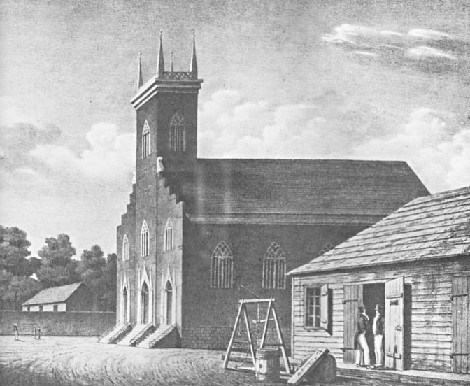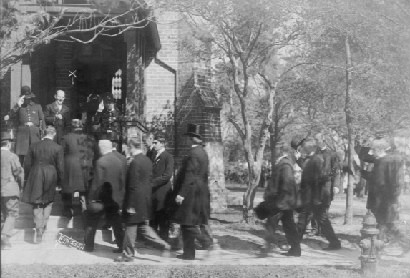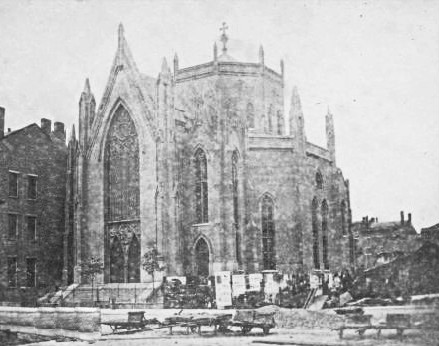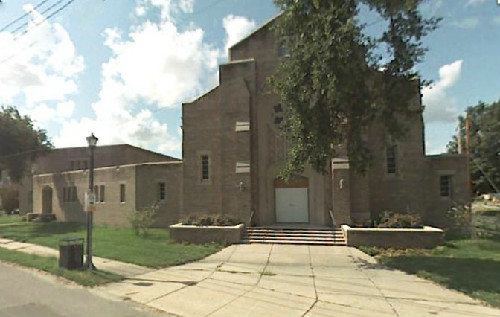
| First Unitarian Universalist Church |



| First Unitarian Church, St. Charles Avenue, sketch ca. 1830's |
| In 1821, the Rev. Dr. Theodore Clapp became minister of the fledgling First Presbyterian Church. Prior to his arrival, the church had been beset by financial difficulty, but was saved with the help of noted philanthropist Judah Touro. Word of Dr. Clapp's excellent preaching skills brought hundreds of people to hear his sermons. So many visitors flocked to the church that it became known as "The Strangers' Church." Dr. Clapp immersed himself in community and civic affairs and worked bravely and tirelessly to aid victims of the Yellow Fever epidemics that occurred during his thirty-five years in the city. |
| By the late 1820's, Dr. Clapp had experienced a change in religious conviction and began preaching universalism, a change not happily accepted by those in authority in the Presbyterian church hierarchy. A trial for heresy was held and Dr. Clapp was convicted. However, back in New Orleans, when he resigned from the church, a majority of the congregation went with him. They formed a church called Church of the Messiah, but, many referred to it as "Parson Clapp's church." The building was on St. Charles Avenue. |
| In 1837, the church became a member of the Unitarian Society and the name was changed to First Unitarian Church. This church building (pictured at top of page) perished in the great St. Charles Hotel fire of 1851. Judah Touro came to the church's rescue once again, providing the money for rebuilding a larger and more impressive sanctuary, located on the corner of St. Charles Avenue and Julia Street. |
| The "Octagon church," First Unitarian Church, corner of St. Charles Avenue and Julia street, ca. 1864. |
| Dr. Clapp served as minister of the church until he retired in 1856, at which time, his son, Emory, became its pastor. Rev. Emory Clapp remained until 1867, having successfully guided the church through the Civil War years. (First Unitarian of New Orleans was one of only two Unitarian churches in the south to survive the war.) In 1902, the Octagon building was sold and a new church was constructed on the corner of Danneel Street and Jefferson Avenue. This building remained until 1958, when a new building was constructed on the site. |
| President Taft attends church service at First Unitarian Church, 1909. |
| In 1950, Rev. Albert D'Orlando began his long service as pastor of the church. Rev. D'Orlando was deeply involved in fighting for social justice and prominent in civil rights causes. His tireless efforts have been featured in the book "Righteous Lives" by Kim Lacy Rogers. Rev. D'Orlando retired from the ministry in 1979, after twenty-nine years as pastor of First Unitarian, but continued to work for social justice for the rest of his life. In 1992, the church moved to a larger property at the corner of Jefferson and Claiborne Avenues. |
| First Unitarian Universalist Church, Jefferson and Claiborne Avenues, 2007 |
| Following the levee failures of 2005, the church sat in 5 feet of flood water and most of its interior was destroyed. The congregation has worked hard to repair the damage and reclaim its church home. Work is ongoing and tremendous progress has been made. |
| To read more about the remarkable life of the Rev. Dr. Theodore Clapp and his experiences in the city of New Orleans, 1821-1856, read the book "Autobiographical Sketches and Recollections During a Thirty-Five Years' Residence in New Orleans" by Theodore Clapp; available at most booksellers. |
| The link to this page is: http://old-new-orleans.com/NO_FirstUnitarian.html Website: First Unitarian Universalist Church Back to Old New Orleans The Past Whispers - Home |